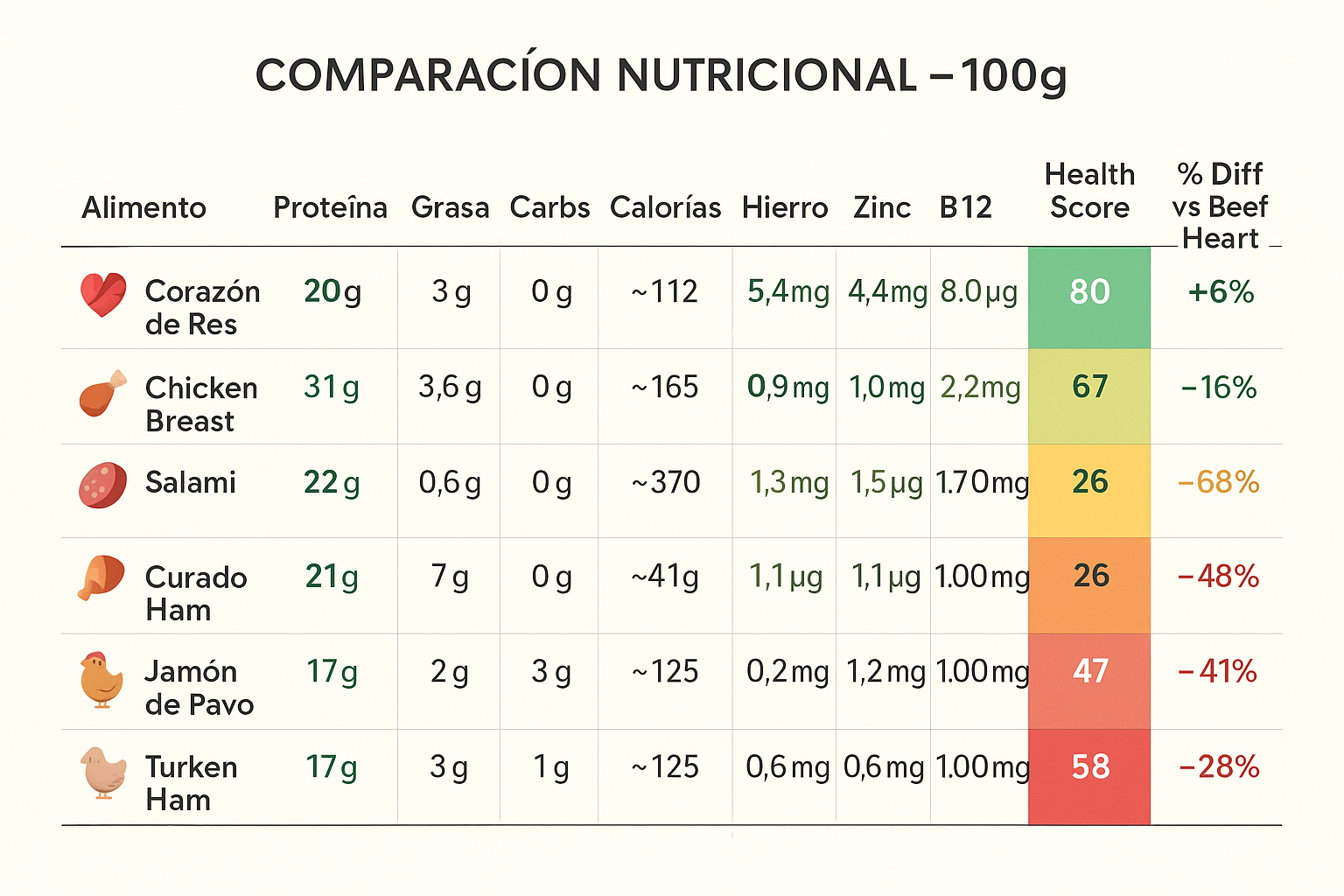The Underrated Superfood: Why Beef Heart Should Be on Your Plate
Nutritional comparison of beef heart with common meats, showing its iron, B12, zinc, and CoQ10 content. Includes cooking methods and ways to add it to your diet.

Introduction
Organ meats are having a quiet renaissance—and leading the charge is one of the most overlooked cuts: beef heart. While the idea of eating heart might seem archaic or extreme to some, the nutritional data speaks volumes. In this post, we’ll compare beef heart with more common meats like chicken breast, salami, and ham, and outline how you can tactically add it into your weekly meals for maximum health benefit.
Nutritional Comparison: Beef Heart vs. Common Meats
| Food | Protein | Fat | Carbs | Calories | Iron | Zinc | B12 | CoQ10 | Sodium | Score |
|---|---|---|---|---|---|---|---|---|---|---|
| Beef Heart | 20g | 3g | 0g | 112 | 5.4mg | 4.4mg | 8µg | 113mg | 98mg | 100 |
| Chicken Breast | 31g | 3.6g | 0g | 165 | 0.9mg | 1.0mg | 0.3µg | 2.2mg | 74mg | 27.4 |
| Salami | 22g | 28g | 1.1g | 370 | 1.3mg | 2.0mg | 1.5µg | 0mg | 1700mg | 0 |
| Cured Ham | 21g | 7g | 1g | 145 | 1.0mg | 1.3mg | 1.1µg | 0mg | 1200mg | 12.1 |
| Turkey Ham | 17g | 2g | 3g | 125 | 1.1mg | 1.2mg | 0.6µg | 0mg | 1000mg | 4.3 |
Key Takeaway: Beef heart dominates in iron, B12, zinc, and CoQ10 content while maintaining a low calorie and sodium profile.
Why You Should Care About These Micronutrients
- Iron (heme): Essential for oxygen transport and energy metabolism (Abbaspour, Hurrell, & Kelishadi, 2014).
- Zinc: Crucial for immunity and wound healing (Maares & Haase, 2020).
- Vitamin B12: Needed for brain and nervous system function (O’Leary & Samman, 2010).
- CoQ10: Supports mitochondrial energy production and cardiovascular health (Littarru & Tiano, 2007).
Tactical Opportunities to Add Beef Heart to Your Diet
Sliced & Seared
- Marinate in garlic, olive oil, and herbs.
- Sear like a steak, medium-rare for tenderness.
- Serve over greens with citrus.
Ground & Blended
- Mix 20–30% beef heart into ground beef for tacos, burgers, or meatballs.
- Great for stealth health if cooking for picky eaters.
Slow Cooked
- Braise with onions, carrots, and broth for 6–8 hours.
- Shred for stews or bowls.
Jerky or Dried Strips
- Dehydrate thin slices for nutrient-dense snacks.
Tartare or Ceviche (Advanced)
- For those experienced with raw preparations and sourcing clean, grass-fed meat.
Raw (For the Adventurous)
- Slice paper-thin and serve with olive oil, sea salt, and fresh herbs
- Perfect for carpaccio-style dishes
- Ensure you’re using the highest quality, fresh beef heart from a trusted source
- Best served immediately after slicing to maintain texture and freshness
Glossary
- Organ Meats (Offal): Internal organs of animals used as food.
- CoQ10 (Coenzyme Q10): A fat-soluble compound aiding energy production in cells.
- Heme Iron: A type of iron found in animal products, more bioavailable than non-heme (plant-based) iron.
- Micronutrients: Essential vitamins and minerals required in small quantities.
Final Thoughts
Eating beef heart isn’t about being trendy—it’s about reconnecting with ancestral nutrition and maximizing vitality per bite. It’s the kind of food that nourishes not just the body, but the blood, the brain, and yes—the heart.
References
- Abbaspour, N., Hurrell, R., & Kelishadi, R. (2014). Review on iron and its importance for human health. Journal of Research in Medical Sciences, 19(2), 164.
- Littarru, G. P., & Tiano, L. (2007). Bioenergetic and antioxidant properties of coenzyme Q10: recent developments. Molecular Biotechnology, 37(1), 31–37.
- Maares, M., & Haase, H. (2020). Zinc and immunity: An essential interrelation. Archives of Biochemistry and Biophysics, 611, 108–109.
- O’Leary, F., & Samman, S. (2010). Vitamin B12 in health and disease. Nutrients, 2(3), 299–316.
💬 Join the Conversation
Share your thoughts, ask questions, or simply let me know what resonated with you. I read and respond to every comment personally.
Comments are loading...
If comments don't appear, you can join the discussion on GitHub
First-time visitors: A discussion thread will be created automatically when you comment.